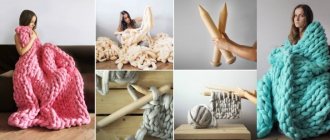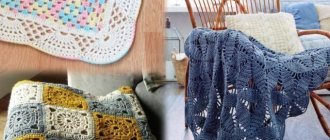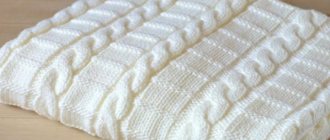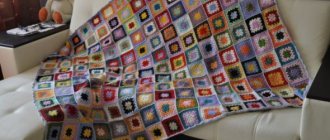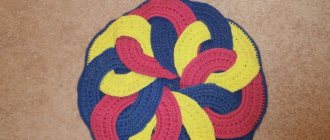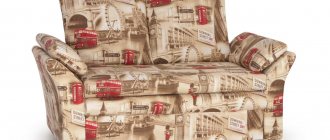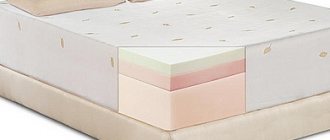Tool selection
All knitting needles vary in size and shape:
- Single straight models.
- Circular knitting needles, with fishing line.
Depending on the shape of the chosen blanket model, you should focus on the choice of knitting needles. The diameter of the knitting needle is also an indicator that depends on the thickness of the thread, the knitting method and the specifics of the pattern.
Knitting pattern Rice
The rice pattern is one of the most popular among the broken elastic patterns, in which one or more columns of elastic are offset every one or more rows. In this pattern, the 1x1 ribbing changes through the row, resulting in a nice voluminous texture.
Dimensions of the finished blanket : Approximately 0.9 m x 1.8 m
Pattern 18 loops 20 rows = 10 cm pattern fig.
You will need: 5.5 mm circular knitting needles Yarn needle Scissors About 1 meter of heavy, thick yarn
Selection of materials
Today, beginners and experienced needlewomen are offered the following types of yarn:
- Wool.
- Acrylic.
- Mohair.
- Angorka.
- Linen threads.
- Alpaca.
Each of the presented models is used to create blankets of different structure, differing in the degree of softness, resistance to washing and stretching, and decorative properties.
Harness
An interesting way to tie the edges of a product - shells
Having finished the blanket with knitting needles, it is advisable to crochet it. This is necessary to increase service life.
To do this you will need a short hook (3 mm) and yarn that matches the fabric.
1st row: tie the perimeter of the product st. b. n.;
2nd row: alternate 2 air. p., 3 tbsp. b. n.;
3rd row: knit 5 tbsp into the ring formed by air loops. n., then fasten 1 tbsp. n. (continue to the end of the row).
Beautiful edge trim with small pompoms
A simple but effective way to finish the edge - with beads
To ensure that the blanket retains its original appearance, follow these tips.
- Do not store knitted items in tight piles, otherwise the yarn will fray.
- Before putting the blanket in the closet, do not forget to wash it. Sweat and dirt attract moths.
- Put moth repellent in your closet.
- Always wash knitted items by hand. The washing machine harms the products (stretches, confuses the wool).
- Wash with warm, but not hot water.
- Do not dry blankets in front of radiators. It is better to lay it out on a flat surface and leave it there until it dries completely.
Wool for a blanket
Natural fiber with a pleasant appearance. It features the greatest possible variety of shades, which allows you to work on creating an original design.
The thread is strong, but the finished product is not durable. After several washes, the blanket may stretch, shrink, or lose its original appearance.
In addition, it will be extremely difficult for novice needlewomen to work with this type of yarn. Baby blankets should not be knitted from pure wool yarn, as the material will scratch the baby’s delicate skin.
We recommend reading:
- Knitting bactus with knitting needles - detailed description with photos and diagrams. Step-by-step instructions and recommendations from craftswomen. TOP 30 best models
- Knitting socks with knitting needles - step-by-step master class with instructions. A selection of the best knitted socks models
- Garter Stitch Knitting - 140 photos and videos of basic garter stitch patterns and projects
Color, pattern, texture: what to focus on?
Beautiful blankets can have different designs. The emphasis can be placed on the pattern, texture or color scheme used in the product. The choice is always individual.
Much depends on the preferences of the owner of the item and the features of the interior in which it will be used.
It is not recommended to use several options at once. Having everything piled up can look tacky.
If a product has no bright accent details at all, this does not mean that it will be inappropriate. Sometimes the simplest options are better than any complex, fancy ideas.
Acrylic for knitting
A synthetic fiber characterized by a pleasant shine of the finished product. The thread is strong, glides easily along the knitting needles, even a novice craftsman can work with it. Finished products are resistant to deformation and frequent washing.
However, acrylic threads are quite cold, so only summer knitted blankets are created using them.
And here https://gidrukodeliya.ru you can visit a real club for lovers of needlework and crafts.
How to properly care for a knitted blanket
Caring for a blanket is not difficult if you know the composition of the threads from which it is knitted. Pay attention to the decor. If it is embroidery, try to select a detergent for knitted and embroidered items at the same time.
- the blanket can be washed in a washing machine on a delicate cycle, but cannot be twisted;
- It is better to wash knitted bedspreads by hand with pre-soaking;
- do not use powder detergents that are difficult to rinse out of thread fibers;
- use liquid and gel laundry detergents;
- It is prohibited to use bleaches and other aggressive products;
- do not hang the blanket to dry, spread it on a flat surface, straightening out the tassels and decor.
When caring for knitted items, gentle detergents and hand washing are used.
A handmade blanket will bring comfort and warmth to your home. Associated with love, it will warm you up in any bad weather better than any fireplace.
Mohair threads
This model is a combined version of yarn - natural fiber with synthetic additives. Using mohair allows you to create surprisingly warm blankets with long pile.
You should not start working with such threads, but with enough experience you can safely start knitting an original blanket. Finished blankets require special care and cleaning conditions.
Using braids and harnesses
When creating a blanket with additional elements, you should use any of the above methods in the main knitting, and in some places adhere to a certain algorithm for creating a pattern (braids, strands).
To decorate the product “oblique”:
- Cast on the number of stitches corresponding to the size of the intended blanket pattern.
- Remove the first gearbox.
- Knit the second stitch first, then the first stitch.
- “Discard” the point of the knitting needle.
- Repeat the above steps to obtain a second thin braid, but knit the lpt not one at a time, but two at a time: first the two farthest ones, then the closest ones.
- Throw the pt onto the knitting needle.
- Repeat point 3.
- Repeat until you get the desired number of braids in the product picture.
- Complete a series of ipt.
- Close Fri.
To create “bundles” on a blanket:
- Cast on 28 stitches on needles, including 2 stitches.
- From the first to the eighth row - 2 purl loops, 2 - opposite stitches alternately throughout the entire row.
- Ninth row: purl 2 stitches, 2 opposite stitches, purl 2 stitches. Drop 8 stitches on the outside needle and leave at work. Work 6 stitches from the left needle: 2 knit stitches, 2 opposite stitches, 2 knit stitches. Return the left stitches to the knitting needle and knit: 2 purl stitches, 2 knit stitches, 2 purl stitches, 2 knit stitches. Complete the row by knitting: 2 purl sts, knit 2 sts, purl 2 sts.
- Rows 10-16: repeat step 2.
- Row 17: purl 2 stitches, knit 2 stitches, purl 2 stitches. Skip 8 sts and insert needle in next 6 sts. Remove all existing stitches from the left needle, picking up the remaining stitches to work with. Complete the row: 2pt, 2pt, 2pt, 2pt, 2pt, 2pt, 2pt, 1pt.
- Rows 18-25 repeat step 2.
- Repeat the above sequence of actions until the required size of the harness pattern on the product is obtained.
- Close the loops.
Angora for blanket
Natural soft and fluffy fiber allows you to create children's blankets with bright patterns and delicate pile.
We recommend reading:
- How to knit a turban with knitting needles - 115 photos and videos of ideas, patterns and features of knitting a turban
Knitting bags - 155 photos and videos on how to quickly knit a stylish bag with descriptions and diagrams
Knitting a jacket: 125 photos and video description of knitting with patterns for beginners and masters
Unfortunately, some of the fluff will be lost during use, and after washing the fluff must be tidied up to return to its original appearance.
Alpaca
This model is also a natural fiber that has a number of pleasant properties:
- The material does not cause allergies, which is important when knitting children's blankets.
- The finished product is resistant to deformation and pilling during washing.
- The blanket will be particularly durable, but at the same time, have a soft pile.
Working with yarn is very easy and quick.
Which yarn is suitable
When choosing a motif for a future product, you need to choose the right thread diameter. “Rice” knitting is most often done with yarn of medium and large diameter. This allows you to get a pattern with a relief outline, reminiscent of convex grains of rice.
Thread parameters are determined by two indicators: the weight of the skein and the length of the thread in the skein. Yarn with a thick thread is indicated by indicators of 120 m/100 g, for a thin thread the indicators are 300 m/100 g. Yarn with average indicators is suitable for knitting “rice”.
For example, 200-250 m/100 g. When knitting a snood, a scarf, or a men's sweater, you can choose a thicker thread to obtain a clear pattern with convex tubercles.
In any case, before starting work, it is recommended to knit a small test sample from the selected yarn. This will allow you to evaluate the pattern and calculate the number of loops to be cast on. Each skein shows the recommended knitting needle or crochet hook size, as well as the suggested knitting density.
Master classes on knitting a blanket
Master classes on knitting blankets are necessary for both beginners in needlework and experienced craftsmen. After all, thanks to detailed instructions and pattern formation patterns, you can decide on the knitting technique and learn the best knitting methods for beginners.
Today, there are a huge number of classic work schemes and original author’s techniques.
We recommend reading:
- Knitting a cardigan: 110 photos and videos on how to quickly and easily knit a stylish and beautiful cardigan
- Patterns for crocheting a tablecloth - 140 photos, descriptions of models and features of crocheting a tablecloth
- Crochet shawl patterns - step-by-step description of how to knit a shawl with your own hands
Weaving into other patterns
The simplicity of knitting a rice pattern allows you to harmoniously combine it with other patterns. Volumetric, protruding tubercles of “rice” can themselves become a decoration of a smooth canvas or be woven into other, larger patterns as details.
Rice columns on the surface
The decoration of the fabric knitted with stockinette stitch will be elements of rice knitting. These can be columns, diamonds or other shapes.
Volumetric elements can be placed as decoration on the front of the product or the item can be knitted with a completely selected pattern.
Filling geometric shapes
Knitted large geometric elements look impressive when filled with smaller details. A simple rice pattern works great for this. Framed by braids, crossed stripes and other large elements, small and convex rice looks impressive and appropriate.
Above is the knitting pattern “Filling Geometric Shapes with Rice Stitch.”
Knitting a baby blanket
To knit a warm blanket for children, it is necessary to comply not only with the color composition, but also with a number of requirements for the fiber:
- The yarn should not cause allergies or prick the baby's skin.
- The fabric should be breathable so as not to overheat the baby and allow the skin to breathe.
Natural types of yarn with a small addition of synthetic fibers have excellent characteristics (this will allow the product not to stretch after the first wash).
Detailed description of how to knit a blanket with your own hands:
- Select a drawing and download its diagram.
- If you have little experience in knitting patterns, it is worth doing a test knitting of the pattern.
- The work is best done with large knitting needles or knitting individual modules, which are then combined into a single product.
- Knitting a module: first of all, you need to cast on the required number of loops on both knitting needles.
- Release one knitting needle and then work with an English elastic band for 5-8 cm. Unlike classic elastic, this model is softer in texture.
- The pattern is knitted strictly according to the pattern.
- The end of the module is also represented by an English elastic band.
Photos of a children's knitted blanket in various modifications can be found in any magazine on practical needlework.
Scheme and description of knitting a pearl pattern (tangle) on knitting needles
This is a completely simple and at the same time beautiful pattern that even a beginner knitter can knit. It consists only of knit and purl loops, which alternate with each other. The knitting is similar to a scattering of pearls or rice, hence the name.
The pearl pattern is attractive because it is double-sided, very dense and holds its shape well, does not stretch or curl. Therefore, pearl knitting is often used for parts that should look the same on both sides. For example, for trims, pockets, collars. But even things completely knitted with tangles on knitting needles look advantageous due to the volume and relief of the surface of the fabric. There are many different patterns where the putanka is combined with braids, arans and other knittings. It is often used to strengthen stocking stitches so that the fabric does not curl.
Modular blanket made of squares
The main feature of this model is the ability to create it from the remains of multi-colored yarn. The finished product takes on an original look that fits perfectly with the high-tech and Provence style of the room's interior.
To work, you need to prepare straight knitting needles, yarn and, if desired, a pattern. Step-by-step instruction:
- Measure the dimensions of the square module.
- Depending on the size of the module, cast on the required number of loops on the knitting needles.
- Release one knitting needle and knit a square according to the chessboard principle: alternating purl and knit stitches 2*2, different in each row.
After creating all the modules, they should be connected with a knitting needle into a single product. Using a hook, you can create an original border along the edges of the blanket.
Color range and size
When choosing a color scheme, you should pay attention to the overall design of the room. A blanket can be in harmony with the main shades of furniture, wall decoration, or, on the contrary, it will be a bright accent in the interior.
In addition, when choosing the shade of a blanket, it is worth taking into account the frequency of use. If the product will be used constantly, you should give preference to a dark tone, because... They get dirty less often and will have to be washed often.
The size of the blanket must correspond to its purpose. The size for a child will be very different from the size for an adult. In addition, if the product will be used as a bedspread on furniture, the dimensions must correspond to the surface that it will cover.
Knitting Canadian elastic
The technique is based on the creation of an openwork motif and relief patterns on the canvas. Before starting work, it is worth creating a ready-made scheme for forming the ornament, deciding on the color composition and size of the blanket.
For beginning craftsmen, the modular principle of operation or the use of circular knitting needles, which allow knitting large items, is best suited.
Oblique knitting technique
To create a diagonal pattern on a knitted blanket, you need:
- Cast on the number of loops corresponding to the size of the product. It is important to keep in mind that this number must be a multiple of four (plus 1 loop at the end for the edge).
- The first row should be worked from the front side: 1 k-ayapt, 3 stitches together, knitted-voypt, yo, 3 pts, knitted together knit-oh pt. Discard all existing stitches from the left needle. Next: 1 knit stitch, 3 stitches together, knit stitch, yarn over, 3 stitches joined together, knit stitch, 1 knit stitch.
- Continue knitting to the end of the row, based on the given algorithm.
- Row 2 should be completely knitted.
- 3rd row from the front side: 2 stitches, 3 stitches together, knitted in a knit stitch, yarn over, 3 loops together, knitted in a knit stitch. Reset all existing pts. Next: 1 pt, 3 pt, knitted together lt, yarn over, 3 pt together, knitted lt, 1 lt.
- Repeat the proposed sequence of stages of bias knitting until there are “extra” stitches left that do not fit the repeat. Knit the remaining pts in lpt.
- Turn the product over.
- Knit row 4 with classic stitches.
- Turn the knitting over to the right side.
- 5th row: 3 lpt, 3 pt, knitted together lpt, 1 lpt. Repeat until the remainder of the points not included in the rapport. “Extra” pt knit lpt.
- Turn the product over.
- Make row 6 completely purl.
- Row 7 (front side): repeat (3 sts, knitted together knit stitch, 1 lpt), repeating until the end of the row. Knit the remaining pt.
- Turn the future blanket over.
- 8 row knit ip.
- Repeat the given sequence of work using the bias knitting technique until you obtain a blanket of the required size.
- Close Fri.
Combed ribbon blanket
Very often, such soft and stylish blankets are knitted by hand without using tools, but using large knitting needles you can also successfully knit a blanket. Advantages for beginner needlewomen:
- Easy working technique.
- A huge selection of instructions, diagrams and educational video lessons.
- Stylish design and bright colors of wool yarn.
However, care should be taken when working with combed tape as the material can tear easily.
Plaid with zig-zag pattern
This pattern for the ornament is one of the simplest. To create an original and beautiful blanket, you should use the instructions:
- Determine the expected width of the blanket.
- Cast on the required number of stitches on the knitting needles.
- Knit the first 5-6 cm with an English elastic band.
- The next two rows of fabric should be garter stitch.
- A zigzag pattern is made with threads of a different color.
- Pattern for the ornament: edge loop, 1 sheet. p., yarn over, 6 l. p., 3 loops knit together, 6 l. n. Repeat until the end of the row, finish 1 l. p., 1 edge loop.
- In the second row, all yarn overs are knitted with purl stitches.
The pattern of the ornament is repeated until the end of the entire blanket, and the last 5-6 cm are knitted with an English elastic band.
Pearl brioche or small putanka
Rapport consists of an odd number of pets.
- 1 r.: cr., *k1, double crochet the loop* - at the end of knit 1, cr.
- 2 r.: kr., *knit 1, remade loop with nak. knit knit*, finish knit 1, cr.
- 3 rows: cr., * 1 p. double crochet, knit 1 *, at the end of 1 p. double crochet, cr.
- 4 rubles: cr., *reshot. knit a stitch with a double crochet, knit 1*, repeat a stitch with a double crochet. - persons, cr.
Alternate from 1st to 4th row.
Photo of a blanket with knitting needles
Did you like the article?
3+
